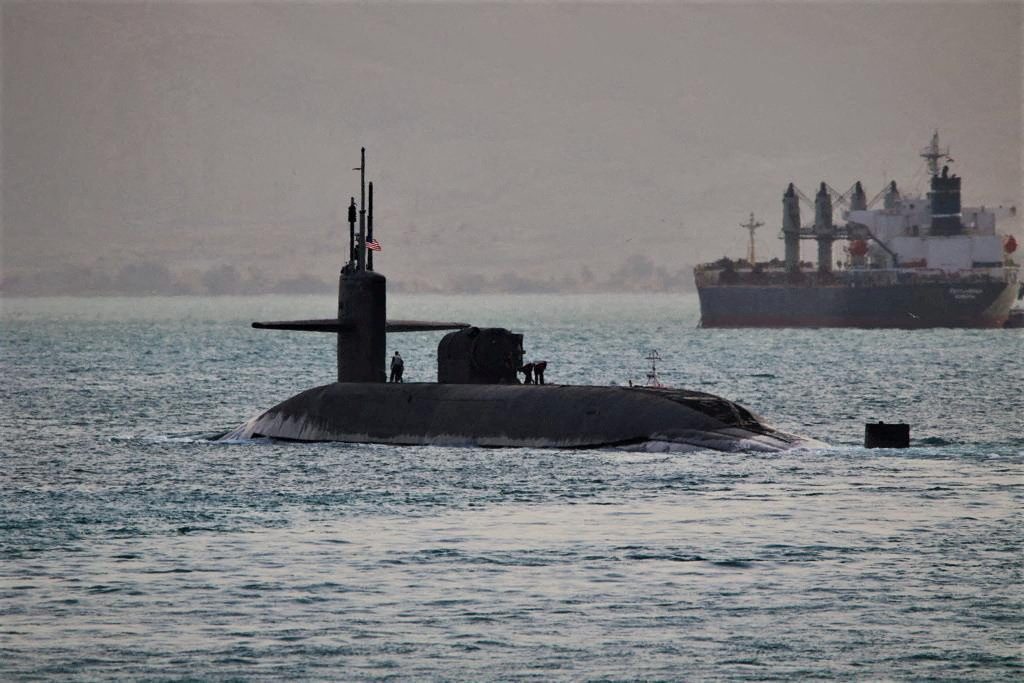By Tony Capaccio
(Bloomberg) –A US nuclear-armed submarine will make a publicly announced visit to South Korea within months, prompting debate about the wisdom of a heightened public role for what’s long been known as the Navy’s “silent service.”
Pentagon officials confirmed that one of the Navy’s 14 Ohio-class vessels will visit, as President Joe Biden signaled in announcing a “Nuclear Consultative Group” during last month’s White House visit by South Korean President Yoon Suk Yeol.
The submarines, nicknamed Boomers, gained the silent service description because they are designed to glide undetected, and their port calls have seldom been disclosed — much less trumpeted — by their usually taciturn commanders. Each of the subs carries up to 20 D-5 Trident ballistic missiles.
The US has occasionally showcased its submarines in the past, but the pace picked up in the last year with publicized port visits by nuclear-armed Ohio-class submarines as well as Los Angeles-class subs carrying conventional Tomahawk cruise missiles.
The Biden administration’s Nuclear Posture Review endorsed such demonstrations last year.
“We will work with Allies and partners to identify opportunities to increase the visibility of U.S. strategic assets to the region as a demonstration of U.S. resolve and commitment, including ballistic missile submarine port visits and strategic bomber missions,” it said.
On April 18, days before the US-South Korea proclamation, the US Navy announced that the Ohio-class USS Maine made an on-surface logistics stop at the naval base in Guam.
Ronald O’Rourke, chief naval forces analyst for the Congressional Research Service, cited “unusual Navy actions late last year to publicize the presence” of nuclear-armed vessels “in the Arabian Sea, at Diego Garcia, at Gibraltar and in the Atlantic.”
He said it’s not clear whether the upcoming South Korea visit is part of such a new “public signaling strategy” or a one-time decision “reflecting circumstances specific to the security situation on the Korean Peninsula.”
‘Red October’
The Navy has long been fond of the publicity it gains from cooperating with filmmakers on movies from “The Hunt for Red October” in 1990 to the 2018 potboiler “Hunter Killer.”
Ohio-class submarines are the US Navy’s largest ever. At 560 feet long (171 meters) and displacing 18,750 tons when submerged, they dwarf the cruisers and destroyers used in World War II surface combat. Their Trident missiles can be configured to hold as many as 14 nuclear warheads, each capable of being guided to a different target, and boast a range of 4,000 nautical miles (7,400 kilometers), according to the Navy.
Most of the Navy’s subs “still hide in the oceans, but from time to time they have made port calls, and soon they will add South Korea to the growing list,” said Hans Kristensen, director of the Federation of American Scientists Nuclear Information Project.
It’s part of a new assignment “that contradicts their core mission of staying undetected,” he said. “But nuclear signaling is now considered so important because of competition with Russia and China that even the ‘silent service’ will occasionally show itself.”
It also may reflect efforts to counter the reality that the US submarine force is shrinking and having readiness problems, said Bryan Clark, a former special assistant to the chief of naval operations and now a naval fellow with the Hudson Institute.
“Those concerns are true, but US submarines are still the quietest and most sophisticated in the world,” he said.
Increased visibility could have its downside, especially the South Korea visit, said Brent Sadler, the Heritage Foundation’s senior research fellow for naval warfare and a Navy veteran with numerous submarine tours.
The visit would expose the vessel to North Korean or Chinese monitoring and they “could use the knowledge to hold our submarines on deterrent patrols far away at risk,” Sadler said. The strategic messaging of support for South Korea “would be minimal” for the US “to take some significant risks to send such a boat that far forward,” he said.
© 2023 Bloomberg L.P.

 Join The Club
Join The Club











